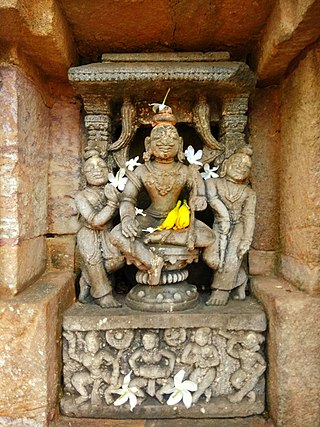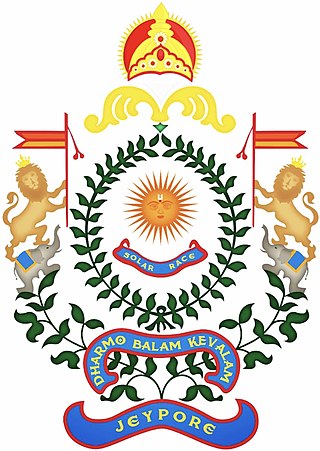Kalinga, is a historical region of India. It is generally defined as the eastern coastal region between the Mahanadi and the Godavari rivers, although its boundaries have fluctuated with the territory of its rulers. The core territory of Kalinga now encompasses central and southern Odisha and northern Andhra Pradesh. At its widest extent, the Kalinga region also included parts of present-day Chhattisgarh, extending up to Amarkantak in the west.

Jeypore is one of the largest towns and a place of historical significance in Koraput district in the Indian state of Odisha. It was established by Vir Vikram Dev in the mid 17th century. The kingdom was defeated by the East India Company in 1777 who declared it a Zamindari or Feudatory of the British Crown and much later got acknowledged as a Princely state until its dissolution in the Dominion of India in 1947.

Krishnadevaraya was an emperor of the Vijayanagara Empire reigning from 1509 to 1529. He was the third monarch of the Tuluva dynasty, and is considered to be one of the greatest rulers in Indian history. He ruled the largest empire in India after the fall of the Islamic Delhi Sultanate. Presiding over the empire at its zenith, he is regarded as an icon by many Indians. Krishnadevaraya earned the titles Andhra Bhoja, Karnatakaratna Simhasanadeeshwara, Yavana Rajya Pratistapanacharya, Kannada Rajya Rama Ramana, Gaubrahmana Pratipalaka and Mooru Rayara Ganda. He became the dominant ruler of the peninsula by defeating the sultans of Bijapur, Golconda, the Bahmani Sultanate and the Gajapatis of Odisha, and was one of the most powerful Hindu rulers in India.

Paralakhemundi shortly known as Parala is district Headquarter of Gajapati district and one of the oldest Municipality established in 1885, in the Indian state of Odisha. Majority of the people in the town speak Odia. The city and the District share its boundaries with Andhra Pradesh. The adjacent town of Pathpatnam is separated by the River Mahendra Tanaya.In later medieval period it became capital of Paralakhemundi Estate of Eastern Ganga Dynasty kings of Khemundi Branch. The town is well known for being an ancient cultural center of Odisha and birthplace of noted personalities including poet Gopalakrusna Pattanayaka, statesman Krushna Chandra Gajapati Narayan Deo, lexicographer Gopinatha Nanda Sharma and historian Satyanarayana Rajguru. This town is also known for its century old temples, monasteries, palaces and heritage buildings.

Dhenkanal State was one of the princely states of India during the period of the British Raj. The state is now referred to as Dhenkanal district, Odisha, with Dhenkanal town as its district headquarters.

The recorded history of Andhra Pradesh, one of the 28 states of 21st-century India, begins in the Vedic period. It is mentioned in Sanskrit epics such as the Aitareya Brahmana. Its sixth-century BCE incarnation Assaka lay between the Godavari and Krishna Rivers, one of sixteen mahajanapadas. The Satavahanas succeeded them, built Amaravati, and reached a zenith under Gautamiputra Satakarni.

The Eastern Ganga dynasty were a large medieval era Indian royal Hindu dynasty that reigned from Kalinga from as early as the 5th century to the mid 20th century. Eastern Gangas ruled much of the modern region of Odisha in three different phases by the passage of time, known as Early Eastern Gangas (493–1077), Imperial Eastern Gangas (1077–1436) and Khemundi Gangas (1436–1947). They are known as "Eastern Gangas" to distinguish them from the Western Gangas who ruled over Karnataka. The territory ruled by the dynasty consisted of the whole of the modern-day Indian state of Odisha, as well as major parts of north Andhra Pradesh, parts of Chhattisgarh and some southern districts of West Bengal. Odia language got official status in their regime following the evolution of the language from Odra Prakrit. The early rulers of the dynasty ruled from Dantapuram; the capital was later moved to Kalinganagara, and ultimately to Kataka and then to Paralakhemundi.

Gajapati Langula Narasingha Deva I was an Eastern Ganga monarch and a warrior of the Kalinga region who reigned from 1238 CE to 1264 CE. He defeated the Muslim forces of Bengal who constantly threatened the Eastern Ganga dynasty's rule over his kingdom of Kalinga from the times of his father Anangabhima Deva III. He was the first king from Kalinga and one of the few rulers in India who took the offensive against the Islamic expansion over India by Turko-Afghan invaders of Eastern India. His father had successfully defended his kingdom against the Turko-Afghan rulers of Bengal and crossed into Rarh, Gauda and Varendra in Bengal chasing the invaders on backfoot. He became the dominant ruler of the peninsula by defeating the Turko-Afgan, Gouda, and the powerful monarch of the south kakatiya Dynasty king Ganapati Deva, and was one of the most powerful Hindu rulers in India. He also built the Konark temple to commemorate his victories over the Muslims as well as other temples and the largest fort complex of Eastern India at Raibania in Balasore. He also built famous Varaha Lakshmi Narasimha Temple at Simhachalam , Andhra Pradesh. The Kendupatana plates of his grandson Narasingha Deva II mention that Sitadevi, the queen of Narasingha Deva I was the daughter of the Paramara king of Malwa.

Kondapalli Fort, also locally known as Kondapalli Kota, lies to the west of Kondapalli in Vijayawada the second largest city of Andhra Pradesh, India of NTR district,. This historical fort also known as Kondapalli Quilla was built by Prolaya Vema Reddy of Reddi Kingdom during the 14th century CE. It was initially built as a leisure place and business center and later served as a military training base for the British rulers. According to some other historians it was built in 1360 CE by Anna Vema Reddy after he captured Kondapalli from Mudigonda Chalukyas, the fort has been home to several dynasties, from the Reddi rulers to the Nizam Nawabs, and then the East India Company.

Kapilendra Deva was the founder of the Suryavamsa Gajapati Empire that ruled parts of eastern and southern India, including present-day Odisha as the center of the empire. He came to the throne after staging a military coup against the preceding and the last ruler from the Eastern Ganga dynasty, Bhanu Deva IV. His name is also written as Kapilendra Routray or Sri Sri Kapilendra Deva. Kapilendra claimed descent from the Surya Vamsha of the Mahābhārata and took the title of shri shri ...(108 times) Gajapati Gaudeshwara NabaKoti Karnata Kalabargeswara or the lord of Bengal (Gauda), of the Karnataka region or Vijayanagara, the lord of Gulbarga and of nine crore subjects.
The Bhanja dynasty is a dynasty that originated in the northern and central regions of modern Odisha before the Gupta Empire became an imperial power. The dynasty, of ancient local Kshatriya lineage as documented by Hermann Kulke, succeeded the Vindhyatabi branch of the Nagas of Padmavati, who ruled from the Keonjhar district of Odisha and included Satrubhanja of the Asanpat inscription. The Bhanj later became feudatories of the Bhauma-Kara dynasty.

Dibyasingha Deba, known by the symbolic regnal title as Gajapati Maharaja Divyasingha Deva IV is the current titular Gajapati Maharaja and the King of Puri. He is the current head of the house of Bhoi dynasty, who were the hereditary rulers of the ancient realm of Trikalinga, medieval era Khurda Kingdom and the rulers of the Puri Estate, with their current capital located at Puri. The Gajapati Maharaja is the current Adhyasevaka of Lord Jagannatha and according to customs also considered to be the living reflection of the Lord. He is also the chairman of the Shri Jagannatha Temple Managing Committee of the Jagannath Temple at Puri.
Vishvanatha Deva Gajapati was the king of Kalinga who established a kingdom in the region of Odisha and Andhra Pradesh, historically known as Kalinga. He belonged to the Shankara dynasty that was installed in the region by his great-grandfather Vinayaka Dev and his wife Lilavati. The Silavamsa king Pratap Ganga Raja died without any male heir, only leaving behind his wife and daughter Lilavati. Vinayak Dev who migrated from Jammu or Kashmir after praying to Kashi Vishwanath married Lilavati. Accordingly, the dynasty was called Shankara dynasty. Vinayak Dev also claimed to belong to the legendary Solar dynasty or Suryavansh.

Parlakhemundi estate was a Zamindari of Odisha in the British Raj period .Before odisha province formation it was under Madras Presidency.The state was ruled as an independent kingdom till 1769.The royal family belong to the Krishnatreya gotra Odia Kshatriya and traced their lineage to Eastern Ganga Dynasty.It was a zamindari estate lying in the southwestern portion of Ganjam district, covering an area of 615 square miles. It was bounded in the south by the district of Vizagpatnam and on the west by the jeypore zamindari and the tribal agencies of the Eastern Ghats.

The Bhoi dynasty or the Yaduvamsa dynasty were a medieval Hindu dynasty from the Indian subcontinent, which originated in the region of Odisha that reigned from 1541 to 1560 CE. Govinda Vidyadhara had usurped the throne from the later weaker Suryavamsa Gajapati Empire rulers as the kingdom started weakening but had a short-lived reign as ruling chiefs of Odisha as the ensuing internal rivalries and constant threats of invasions rendered them weak and were eventually overthrown by Mukunda Deva of Chalukya dynasty in 1560.

Maharaja of Jeypore was the principal title used by the rulers of the Kingdom of Jeypore until its dissolution in 1947. It was also used by the titular rulers until the removal of titles and privileges of all princely states and estates by the 26th amendment of the Constitution of India. However, due to the significance given to the traditional and religious role of a king, evidently, Vishweshwar Dev in 2013 became the Maharaja of Jeypore in pretense.
The Puri Estate was an estate ruled by the main branch of the Bhoi dynasty, who were reinstated in Puri in 1809 following the 1804 rebellion against the British and annexation of the Khurda Kingdom which were under their control. After the rebellion led by the Khurda king, Mukunda Deva II, the British decided to take control of the administration of the Khurda kingdom and Mukunda Deva II was exiled to Cuttack and Mindapore but was later reinstated and pensioned off to Puri to remain as a titular head of the dynasty while retaining control over the Jagannath Temple.
Gajapati is a regnal title from the region of modern Odisha in the Indian subcontinent. The word ‘Gajapati’ in Odia refers to "Gaja" meaning elephant and "Pati" meaning master or husband. Thus Gajapati etymologically means a king with an army of elephants. The institution of Gajapati kingship as a title was used by the Eastern Ganga dynasty and was used by succeeding dynasties, with the patronisation of Lord Jagannatha as the imperial deity of the Odia cultural realm.













